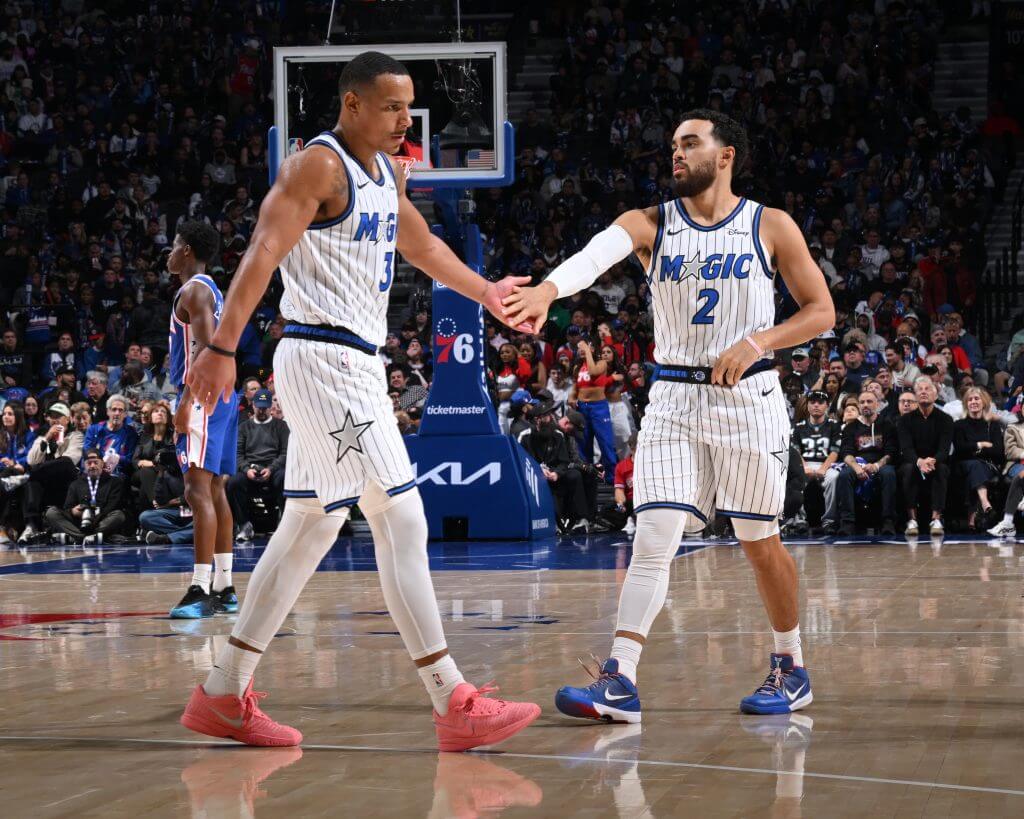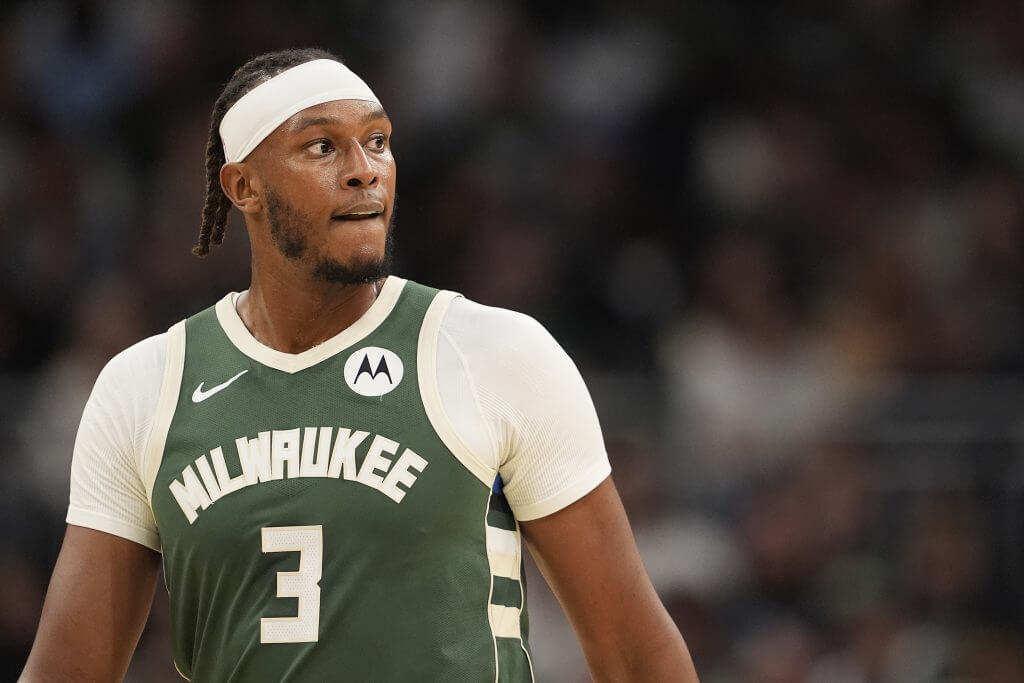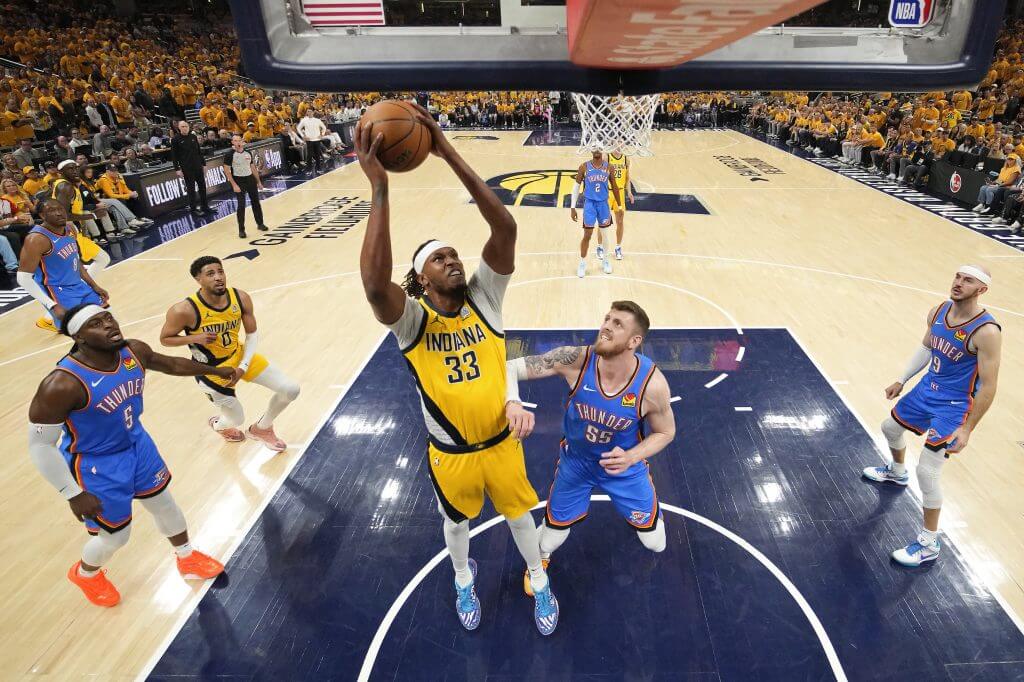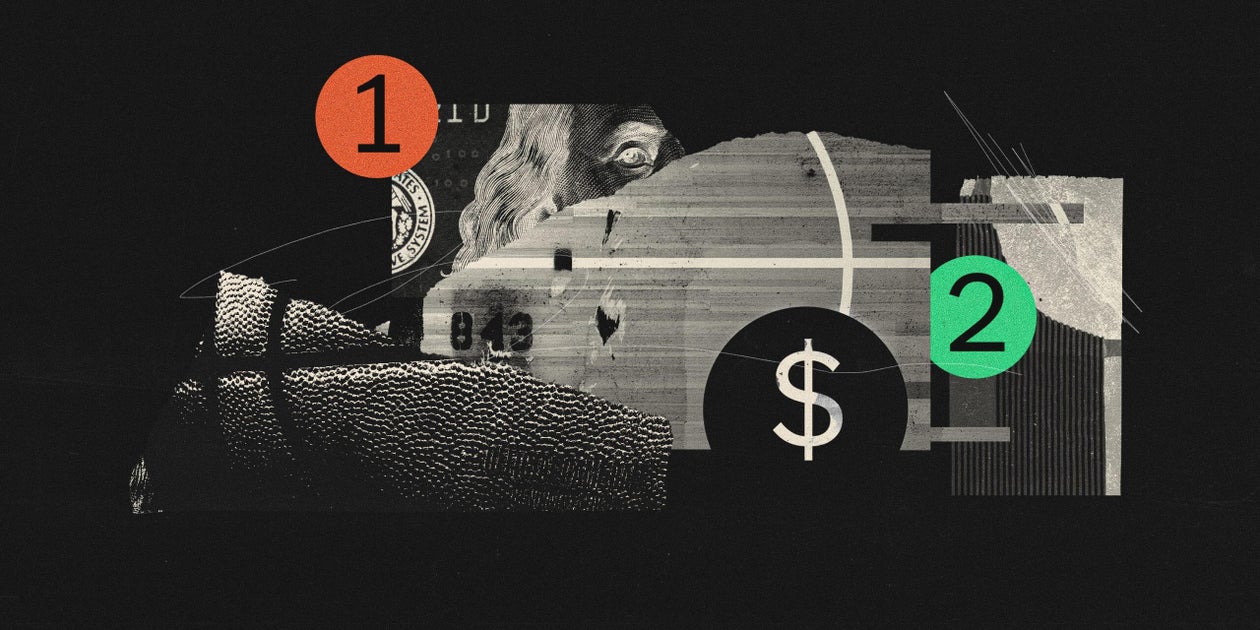Editor’s note: This story is part of an ongoing, multi-part series examining the big-picture trends and concerns about the current NBA.
The second apron is busting up your favorite teams, kicking homegrown players out of their markets, taking money from their pockets.
The NBA’s most storied franchise, the Boston Celtics, broke apart their latest championship roster just one year removed from a title parade because of it. About 10 minutes after losing Game 7 of the finals last summer, the Indiana Pacers let a favorite son walk to a division rival, rather than even flirt with keeping him.
Free agency was boring, restricted free agent signings took too long and some of the best role players in the business are on below-average contracts, all because the second apron looms. Thanks to it, the Cleveland Cavaliers, Orlando Magic and even the reigning champion Oklahoma City Thunder have tough decisions facing them if they don’t win this season.
“What we’re finding is that that second apron is sort of functioning like a hard cap, which was a little bit unintended, at least from the player side,” said the Detroit Pistons’ Duncan Robinson. “I didn’t think that we fully grasped that that was gonna be the case.”
What sounds like a handy accessory for a butcher or baker on a particularly messy day, the second apron became the star of the 2023 collective bargaining agreement between the NBA’s 30 owners and the players’ union because it reset, at least until 2029, how league executives build their teams.
The NBA has a salary cap — this season it’s $154.6 million, a 10-percent increase over last season — but teams can go over that. If a team spends more than $195.9 million, it is in the first apron and is restricted on how it can acquire a player in trades, who it can sign as free agents and for how much money. Should those teams exceed $207.8 million, they arrive in the second apron, and have even harsher roster constraints, including using draft picks in trades. Those constraints become almost catastrophic if teams spend their way into the second apron year-after-year-after-year.
The aprons, which were the owners’ second choice after their request for a hard salary cap was rebuffed, as it has been in every labor negotiation since at least 1983, should in theory make the annual quest for the Larry O’Brien trophy a more open competition from year to year because the penalties for spending past them are severe. More parity should, the owners contend, mean a higher number of competitive games for league partners to broadcast, more jersey sales, better attendance — i.e., more profit.
“The owners really wanted to go with parity — that was the number one thing,” said Grant Williams of the Charlotte Hornets, who is a players’ union vice president and was in on labor negotiations. “How will parity impact revenue? If it’s a more competitive league, like the NFL, with parity from top to bottom, it goes to impact revenue across the course of the season.
“And for us, we sacrificed with the apron rules to be able to have that.”
The players extracted from the owners concessions that forced historically lower-spending teams to pay more money for players; made more money available to players on teams that stay below the league’s soft salary cap; gave greater flexibility to make trades for most teams; created money for second-round picks and, perhaps at the other end of the earning spectrum, more money for players signing contract extensions. Also, teams pay lower tax rates for simply spending over the cap, but not reaching either apron, which the owners like but it also makes it less expensive for them to sign players — which means more chances for players to sign for big dollars.
The union says 27 of 30 teams have more incentive and ability to spend under the new rules, the value of contract extensions jumped by half, and there are more players in the “upper middle class” of salary earned (making between 15 and 24 percent of their team’s salary cap) than in years past.
“The money is there,” Williams said. “What we’ve seen is that people are still getting paid, just in different locations. So it’s in locations that they necessarily don’t want to travel to or be.”
But there’s that old saying, “perception is reality,” and in this case it doesn’t sound like the new CBA is working for the rank-and-file NBA player — be it in terms of money or where they’re getting paid.
“You can look at countless guys across the NBA and everybody but the stars are getting kind of f—–,” said Larry Nance Jr., an 11th-year veteran playing on a minimum contract for one of the league’s most expensive rosters.
“There was just less money,” said the Orlando Magic’s Tyus Jones, one of the best, if not the best, backup point guards in the NBA who has been a free agent each of the last two years and both times signed contracts for less than the average player’s salary.
“I feel like if the apron wasn’t there, I would have got an extension (instead of) being traded here,” opined Norman Powell, now of the Miami Heat and formerly of the LA Clippers, who was the latter’s second-leading scorer and top 3-point shooter last season.
Powell, who is making $20.5 million this season in the last of a five-year, $90 million contract, said new salary rules are “annoying because (they) limit guys like me and some of the other guys. So even this summer, you see guys holding out, trying to figure out what their deal is, not getting the right offer, the numbers that they think they deserve. It’s just frustrating all around.”
Following an offseason in which the “second apron” seemed to be the story of the summer, The Athletic asked players how they felt about the league’s new salary rules. Players obviously impacted by those rules, star players on expensive teams, and players who know their futures on their current teams likely hinge on team management’s appetite to spend above the aprons, expressed either ignorance, indifference, or a dislike of the salary apron provisions.
They know their union agreed to the changes, and, for what it’s worth, they support former union president CJ McCollum and his bargaining team’s effort in the negotiations. (Nance, a former teammate of McCollum’s in New Orleans, made it a point to say his objections had nothing to do with McCollum.)
New executive director for the players’ union — former star Andre Iguodala — and his staff have increased communication with the players tenfold over past union executives, players say, when it comes to salary cap issues.
Which means the union has heard what The Athletic heard from players — they don’t like the salary rules.
The Magic are one of the teams under pressure to win because they became a big spender last summer. They awarded star forward Paolo Banchero a five-year deal worth a projected $240 million in July that could escalate even higher if Banchero makes an All-NBA team this season, as well as a five-year, $150 million extension to point guard Jalen Suggs, on the heels of the five-year, $224 million extension granted to Franz Wagner last year. They also traded for Desmond Bane, who is in Year 2 of a five-year, $197 million extension.
Based on the timing of the various extensions and when they kick in, the Magic, as constructed, are headed for the second apron next summer. Which means there will be enormous pressure on them to win this year and next.
“That’s just the way the league is,” Banchero said. “If something isn’t working after two, three years, then the team is going to move on and change, make a decision, make a tough decision. Everyone on the team understands that, that this group isn’t forever.”
Bane learned that lesson the hard way. Selected 30th in 2020, Bane played his first five seasons in Memphis, where he was a core component along with Ja Morant and Jaren Jackson Jr. All three of them were awarded nine-figure contract extensions, and Bane had no desire to leave his friends on the Grizzlies. But after years of playoff failures, and the offcourt troubles (and injuries) Morant suffered that seemed to stunt the team’s growth, Memphis chose to trade Bane to get cheaper and gain access to the roster flexibility needed to make trades and free-agent signings when the team feels it is again time to contend.
“I think that we’d be naive to say that it didn’t have anything to do with it,” Bane said, referring to his being traded due to salary rules. “There is only so much money to go around. You know where our team was at, we just got swept by OKC. It probably didn’t feel like we were at the point where we’re knocking on the door of a championship. So it’s like let’s reevaluate and find a way to get more mid-level contracts so then you have more flexibility for the future. I understand that.”
Bane said he thinks the owner’s goal of the aprons — to create more parity — will be achieved. His concern is he hopes the aprons “don’t hurt guys getting the money that they deserve.”

Orlando’s Desmond Bane (left) and Tyus Jones understand better than most players how tenuous life in and around the second apron can be for an NBA team. Photo by David Dow/NBAE via Getty Images
That’s exactly what happened, or seems to have happened, to Bane’s friend and teammate — both in Orlando and previously in Memphis — Tyus Jones.
Jones hit free agency in 2024, and after posting career highs in scoring, assists, and 3s with the Wizards, managed just a one-year, $2 million deal with the Suns. Phoenix’ books were already overstuffed with high-priced salaries, but Jones said he felt his earning potential on the open market was limited by the new salary rules, and exacerbated by his own indecision as to whether he would return to the Wizards.
After a tough season for the Suns in which major changes were implemented, Jones knew he would not be returning to Phoenix, and signed a one-year, $7 million deal with Orlando. It’s better, but still below the league’s $11 million salary average.
“The last couple summers, for sure, especially last offseason, I felt like I was one of the people who it kind of impacted the most,” said Jones, talking about the aprons. “But at the same time, that’s a part of it. The league is forever evolving. So it was just the timing of that free agency.
“And it was a good learning experience for everybody. I’m still learning it, still trying to figure it out as are other players, as our teams. I think front offices are trying to figure out how they should move and how they want to kind of plan for their now and their future just with the new CBA. So it’s a learning process.”
Those were the nicest comments about salary rules players who spoke to The Athletic expressed.
“I’m not a huge proponent of the way it’s affected the middle, the mid and lower tiers of NBA salaries,” said Nance, who returned to the Cavs as a free agent after spending the last four seasons with Portland, New Orleans, and Atlanta. “In a perfect world, I would have liked to see them brought up. I would have liked to see more distribution of the money amongst the roster, not just for myself, for the rookies. I want to see them make some more money. The two ways (players under contract to play in the NBA and G League), they should make more.
“I would like to see more money for the guys that are maybe just having a cup of coffee, we need to set them up. We need to set them up better and set them up longer.”
The Cavs are the only NBA team currently over the second apron, with salaries totaling $230 million (the second apron is $207.8 million) this season. Nance, who will turn 33 on New Year’s Day, has battled numerous injuries during the last several seasons, and wanted to return to a winning team with which he was familiar.
To Nance’s point, the NBA’s “lower class” of players, or players earning less than 10 percent of the salary cap per team, is roughly 33 percent of all players. The middle and lower middle class tiers of players (in terms of salary) have also remained stagnant, and Nance wants those players to earn more money, especially earlier in their careers.
Kyle Kuzma is by no means among the league’s lower or middle-class earners. Traded by Washington to Milwaukee last year, Kuzma is in the third year of a four-year, $90 million contract. He plays alongside Giannis Antetokounmpo, one of the NBA’s best and most handsomely paid players, and his new teammate is Myles Turner, whose four-year, $109 million contract from the Bucks was more than what he could get from the Pacers because they were unwilling to spend that kind of money with All-Star Tyrese Haliburton lost for the season.

Myles Turner had spent his entire career in a Pacers’ uniform. But after their star guard Tyrese Haliburton tore his Achilles tendon in Game 7 of the NBA Finals, the Pacers decided to allow Turner to leave in free agency. Photo by Patrick McDermott/Getty Images
The Pacers’ loss, you might say, was the Bucks’ gain, but Kuzma is no fan of the salary rules that led to them getting Turner.
“The way the CBA is now, it definitely doesn’t favor the love of the game or just the sport aspect,” Kuzma said. “When you think about teams in the ‘80s, teams in the ‘90s, fan excitement was because teams can stay together for many many years and they can build. … You look at a team like Boston, they had to let go of Jrue (Holiday), they had to let go KP (Kristaps Porziņģis) after winning a championship. And that eliminates that fandom for that sports community, right?”
Kuzma added “all the best teams, they grow together and have camaraderie,” and said he felt teams are “just giving up.”
“I guess (the Pacers) didn’t want to pay Myles, and they just gave up after going to Game 7 of the finals,” Kuzma said. “You know, Tyrese is hurt and you got to pay a couple people coming up. Now you have to give away your center that’s been there for 10 years — been a staple in that community.”
While Kuzma’s assessment of what happened in Indiana — Haliburton’s Achilles tear in Game 7, forcing him out for the entire season, forcing the Pacers into a business decision to lower the payroll while Haliburton is out — is widely accepted, Turner downplayed the aprons’ impact on his own free agency.
But Turner also said the NBA’s middle class, of which he knows he is not really a part of, is getting pinched.
“A few years ago, the days of calling the ‘middle class’ or middle guys in the league are getting quote-unquote overpaid, that was nice for a long time for a lot of these guys trying to make way for themselves,” Turner said. “But now you’re starting to see it’s either you’re getting max, big-ass contracts or you’re getting minimum. And it really is affecting a lot of guys within the league.”
The Bucks were among the NBA’s most nimble teams when it came to cap management last summer, making moves that enabled them to get Turner when it looked like they would be hamstrung by their cap sheet. All-Star Damian Lillard suffered an Achilles tear during the playoffs and would miss all of this season; the Bucks waived him and “stretched” the remaining $113 million on Lillard’s contract over five years. To fill in the rest of the roster, the Bucks signed veterans such as Taurean Prince ($3.3 million) and Gary Trent Jr. ($3.7 million), and Turner mentioned that both of them are players who perhaps should be earning more.
“I see guys like, you know, Gary Trent Jr., the Taurean Princes of the world, who had killer years in the last couple of years and not exactly getting the coin that they deserve, but that’s just the way things are shaking out,” Turner said. “I think the average human or people outside of basketball see us all as millionaires, but there’s large discrepancies in these numbers.”
Robinson, a political science major in college at Michigan, called the players’ dilemma with the CBA “champagne problems.” The Heat’s all-time 3-point leader, Robinson declined the roughly $18 million player’s option in the final year of his contract with Miami to become a free agent last summer. But the contract he agreed to with Detroit was essentially for the same money. It was a three-year deal for Robinson, but only the first of the three years is fully guaranteed — for $16.8 million. His contract is only partially guaranteed for next season, at $2 million, if he is on the team on Jan. 10, 2027.
So while the sticker price of Robinson’s contract with the Pistons is three years and $48 million, Robinson is essentially playing on a one-year contract to prove to Detroit, or to someone else, that he is worth that kind of money against their payroll, when it feels like each dollar counts more than it used to. He knows what that kind of money sounds like to the average fan, but within the discussion of how salary rules affect all the players, and not just the best ones, he said “there should be more (money) for everybody.”
“Now I think what you’re seeing is more so teams react right to the pressures of being into that second apron,” Robinson said. “I think you are finding less teams being more willing to put money on their books, especially in that middle-ground area for many years. My hope is that the teams sort of adjust to the second apron and be a little bit more prudent, in terms of planning in the future.”
Like Robinson in Detroit, two of Oklahoma City’s best role players are uncertain where they’ll be next season. The Thunder, who are reigning champs, awarded nine-figure contract extensions to Shai Gilgeous-Alexander, Chet Holmgren and Jalen Williams last summer. The extensions don’t kick in until next season.
As things stand, the Thunder hold team options for next season on the contracts of two crucial role players – Luguentz Dort ($18.2 million) and Isaiah Hartenstein ($28.5 million). Should the Thunder repeat as champs, or even get close, it is conceivable they pick up those options on Dort and Hartenstein and go over the second apron. But both players know it’s an open question that will be in the back of their minds all season.
“I love it here and we’ll see what happens, but I can’t predict the future,” Hartenstein said. “I think if you win, people are more likely to go over the second apron, and if you lose you never know what can happen after that. But yeah, I mean it’s obvious, it’s not like a secret that some players are kinda gonna get pinched out because of the second apron.
Added Dort: “I hope I am rewarded for my hard work, but we will have to let it play out.”

Myles Turner (left) and Isaiah Hartenstein (center) are two players who have been (or likely will be) impacted by the second apron and repeater rules. Photo by Maddie Meyer/Getty Images)

